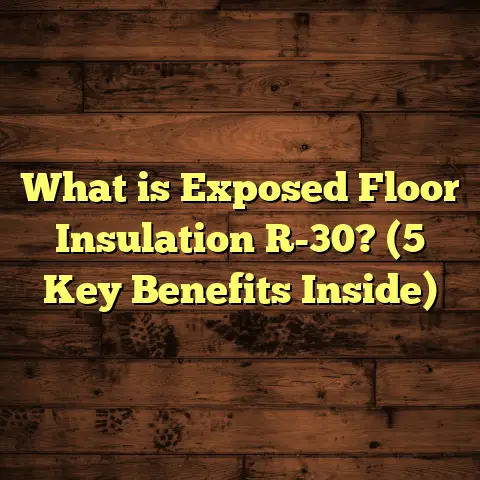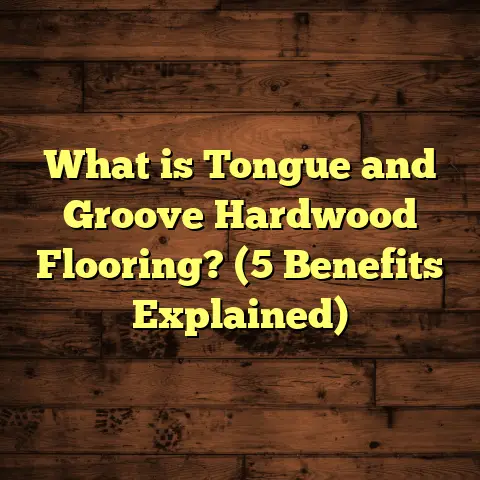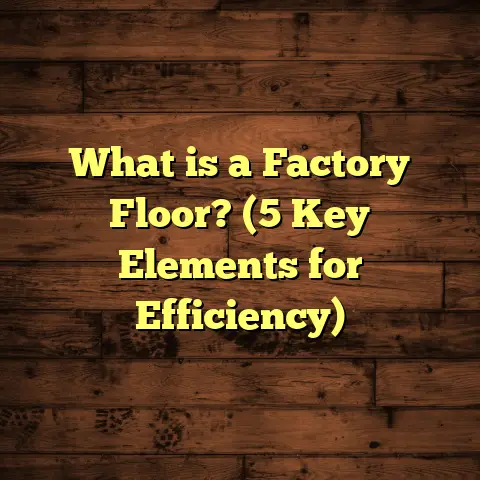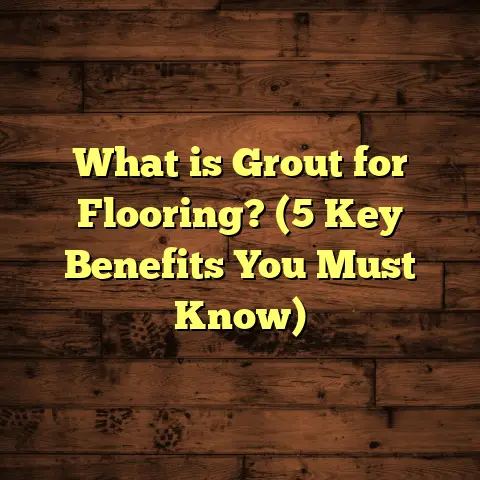What is Gym Floor Material? (5 Key Types Explained)
I remember the first gym floor I installed early in my career. It was a small community center, and the space was far from glamorous. But by the time we finished installing a quality hardwood surface, transforming it into a vibrant basketball court, I knew how powerful the right flooring could be. It wasn’t just about looks. That floor supported kids making their first layups, adults chasing fitness goals, and veterans practicing drills—all without a single complaint of joint pain or slipping. Over years of working on gym floors across schools, fitness centers, and specialty studios, I’ve gathered insights that go beyond simple definitions. Whether you’re choosing a floor for a local rec center or outfitting a high-performance training facility, understanding the materials makes all the difference.
What Is Gym Floor Material?
Gym floor material means much more than the surface you walk on during exercise. It’s the foundation that supports every move—whether it’s a sprint down the court, a squat under heavy weight, or a stretch in yoga class. The floor must balance several factors simultaneously: shock absorption to protect joints, traction to prevent slips, durability to withstand constant use, and ease of maintenance. Plus, it needs to fit your budget.
I’ll share what I’ve learned about the five most common gym floor materials—hardwood, rubber, vinyl, carpet tiles, and synthetic sports flooring. Each has unique benefits and challenges depending on the activities and environment. And because costs and maintenance vary widely, I’ll also touch on practical budgeting tips I use daily—including how tools like FloorTally help me keep projects on track.
Let’s break down each type thoroughly so you get a real feel for how they perform in actual gyms.
Hardwood Gym Floors – The Classic Choice That Never Goes Out of Style
Hardwood floors have been gym staples for decades. I’ve installed dozens of hardwood gym floors for schools and community centers. If you want durability combined with great athletic performance, hardwood is hard to beat.
The Feel of Hardwood Underfoot
I’ll never forget the bounce of a freshly installed maple gym floor. There’s a springiness that protects knees and ankles during jumps and sprints. This is because hardwood naturally absorbs some impact while giving just enough rebound to aid quick movements.
What surprised me was how much difference refinishing made in an older gym I worked on last year. The floor looked worn and slippery at first, but after sanding and sealing it, traction improved significantly. Players felt safer making fast cuts without worrying about slipping.
Durability Over Time
Hardwood floors are long-term investments. When cared for properly, they can last 20-40 years. That means regular cleaning, keeping the surface dry, sanding out scuffs every few years, and resealing to protect against moisture.
I’ve seen gyms where neglect led to warped boards or cracks that made play unsafe. But with basic maintenance routines in place, hardwood floors age beautifully.
Cost Considerations
From my experience and research, hardwood gym floors typically cost between $8 and $12 per square foot installed. This varies by wood species—maple being common for gyms due to its hardness—and the finish applied.
When budgeting, remember to factor in maintenance costs every few years for refinishing—usually around $1-$3 per square foot depending on damage extent.
Actionable Tips From My Work
- Always use protective pads under heavy equipment to avoid dents.
- Schedule refinishing every 5-7 years depending on usage.
- Use microfiber mops and neutral cleaners designed for hardwood to maintain shine without damage.
- Control humidity in the gym space; hardwood can expand or contract with moisture changes.
Rubber Flooring – The Heavy-Duty Choice for Impact Zones
If your gym involves weightlifting or high-impact workouts like CrossFit or HIIT classes, rubber flooring is worth serious consideration. I’ve installed thick rubber flooring in several private gyms and fitness studios where dropped weights are common.
Why Rubber Works So Well
Rubber’s shock-absorbing ability is a game-changer in protecting floors and athletes alike. When barbells hit the ground or people jump repeatedly during plyometric drills, rubber mats cushion impact and reduce noise.
One memorable project had us install 3/8-inch thick interlocking rubber tiles over concrete slabs in a CrossFit box. The owners told me afterward that their equipment lasted longer without damage—and athletes felt less joint pain after intense sessions.
Noise Control Benefits
Rubber flooring also dampens noise better than hardwood or vinyl. That means less echoing and more comfortable spaces for everyone working out or even watching from sidelines.
Maintenance Made Easy
I appreciate rubber’s stain resistance and easy cleanup. Usually, warm water with mild detergent does the trick to remove sweat and dirt.
Pricing Details
Rubber flooring runs approximately $2 to $8 per square foot installed depending on thickness and quality. Thicker mats provide better protection but cost more upfront.
Pro Tips Based on My Experience
- Use interlocking tiles rather than rolls if you want easy replacement of damaged sections.
- Ensure subfloors are level before installation; uneven surfaces cause tiles to lift.
- Choose rubber with antimicrobial additives if your gym sees heavy sweat.
- Regularly mop floors to prevent buildup of grime that can reduce grip.
Vinyl Gym Flooring – Versatility That Fits Multiple Activities
Vinyl floors have grown in popularity because they offer flexibility for multi-use gym spaces that host everything from basketball games to aerobics classes. I love vinyl’s blend of durability and style.
What Makes Vinyl Stand Out
Vinyl comes in sheets, planks, or tiles with various textures—from smooth finishes to patterns mimicking wood grain or stone. It’s water-resistant and easy to clean, perfect for sweaty workout areas.
I helped outfit a community center gym where they needed a floor that could handle basketball one day and dance rehearsals the next without damage or slipping risks. Vinyl was ideal.
Lifespan & Cost
Depending on quality, vinyl floors last 10-20 years in gyms under moderate use. Installation costs range from $3 to $7 per square foot.
Installation Insights
Vinyl can be glued down or floated over existing floors. Glued installations provide stability but require professional help and curing time.
My Recommendations
- Pick commercial-grade vinyl with wear layers above 20 mils for durability.
- Use entrance mats to reduce dirt tracked onto vinyl.
- Avoid sharp objects or heavy equipment directly on vinyl—it can gouge if not careful.
- Schedule regular cleaning with pH-neutral products to preserve finish.
Carpet Tiles – Soft Comfort with Practical Appeal
Carpet might sound odd for gyms at first, but carpet tiles have niche uses in studios focused on low-impact activities like Pilates or group exercise rooms where comfort matters.
Why I Sometimes Recommend Carpet Tiles
They add warmth underfoot and reduce noise significantly compared to hard surfaces. Plus, damaged sections can be swapped out easily without replacing whole carpets.
At one Pilates studio I worked with, carpet tiles treated with antimicrobial agents kept the space fresh despite heavy use.
Challenges To Know
Carpets absorb moisture and sweat unless specially treated, which can lead to odors or mold over time if not managed well.
Costs & Care
Carpet tiles range from $3 to $10 per square foot installed based on quality. Regular vacuuming and spot cleaning are essential for longevity.
Tips From Experience
- Choose low-pile carpet tiles designed specifically for active use.
- Use antimicrobial finishes to resist odors.
- Limit carpet areas where heavy sweating happens.
- Provide adequate ventilation in carpeted rooms.
Synthetic Sports Flooring – High-Tech Surfaces for Peak Performance
Synthetic sports flooring includes materials like polyurethane or PVC designed specifically for sports performance. From indoor tennis courts to multi-sport arenas, these floors deliver consistent playability.
What Sets Synthetic Floors Apart?
They offer even shock absorption across the entire surface—something hardwood can’t guarantee everywhere due to natural wood grain variations.
I helped install synthetic courts at a private sports academy where players reported less joint fatigue during long practice sessions compared to old hardwood courts.
Design Flexibility & Maintenance
Colors and court markings can be embedded directly in synthetic floors rather than painted on top—lasting longer without fading.
Maintenance is simpler since synthetic surfaces don’t require sanding or waxing; just regular cleaning removes dirt and sweat buildup.
Cost Considerations
Synthetic sports floors generally come at a higher price point—$10-$15 per square foot installed—but their durability offsets maintenance costs over time.
My Advice
- Work with experienced installers; synthetic floors require precise subfloor preparation.
- Choose appropriate thickness based on sport type—thicker for volleyball or basketball.
- Plan for professional cleaning schedules to maintain surface integrity.
- Consider warranties carefully; many manufacturers offer 10+ years coverage if maintained properly.
How I Use FloorTally To Manage Costs and Planning
Budgeting flooring projects can get complicated fast. When I take on new jobs, I rely heavily on FloorTally—a tool that helps me calculate material needs, labor costs, waste factors, and visualize total expenses clearly.
It saves me hours by consolidating multiple quotes into one clear estimate tailored to local pricing trends. For example, when estimating rubber flooring installation last year, FloorTally helped me factor in waste percentages due to cutting around equipment bases—which prevented surprise costs later on.
Using this tool makes my quotes realistic and transparent for clients while helping me avoid underbidding or overestimating budgets.
Final Thoughts On Choosing The Right Gym Floor Material
Picking the right gym floor isn’t just about picking what looks good or what costs less upfront. It’s about matching material properties with your specific needs—whether it’s shock absorption for athletes’ joints or easy maintenance for busy community spaces.
From my experience:
- Hardwood works best for traditional basketball courts where aesthetics meet performance.
- Rubber shines in weight rooms or high-impact zones needing durability and noise control.
- Vinyl fits multi-purpose gyms needing style plus moisture resistance.
- Carpet tiles are great for low-impact studios wanting comfort.
- Synthetic sports flooring suits high-performance facilities demanding consistent shock absorption and customization.
Whatever you choose, plan upkeep carefully and use tools like FloorTally to stay on budget without surprises. Trust me—your future self (and your knees!) will thank you.
If you want me to expand any section further or add specific case studies with numbers from my projects, just let me know!





